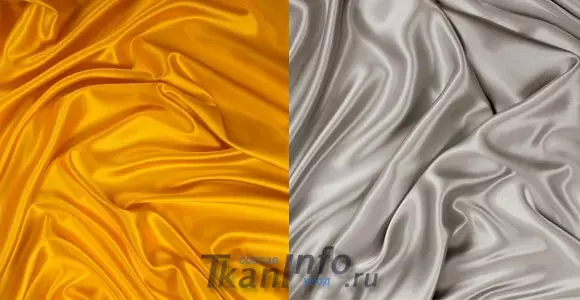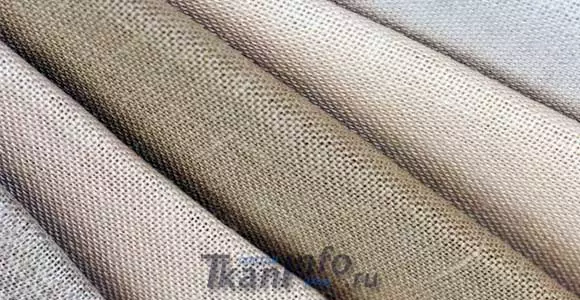A huge range of fabrics is classified by several signs:
- in composition;
- by the method of weave;
- by appointment;
- for season;
- Finishing.

All woven materials on the composition of the fibers are divided into artificial, mixed and natural. The first are made solely from synthetic materials, the second - combine natural raw materials and artificial, third - completely woven out of natural fibers.
Most often, natural and mixed fabrics are used for tailoring and household goods. The group of materials from natural fibers includes such types:
- silk;
- cotton;
- woolen;
- Cotton.
The name of the materials may be the same, and the composition of the fabric is completely different . This is explained by the fact that the material is often referred to by the method of weave, and the same interweaving is used for all types of raw materials.
Consider what fabrics are from natural fibers.
Silk group
The name of the fabrics and their detailed characteristics can be seen in our column "From A to Z". It is worth distinguishing natural and artificial silk, since this group includes materials not only from pure silk, but also from mixed and fully synthetic raw materials. Moreover, the fraction of silk from chemical fibers is more than 90%. This is connected not only with progress in the textile industry, but also with a high price of natural silk.The characteristic of silk tissues is usually limited to a description of the appearance. The material from silk yarns is really very attractive: it glitters and overflows in the sun, light, soft and pleasant to the touch. In addition, silk has high utilitarian properties: hygroscopicity, low shrinkage, is well draped. This is lightweight, elastic and durable matter.
The production of silk fabric is a very time-consuming and cost-consuming process, so natural material has a greater cost and is highly appreciated in the market. Raw materials for silk threads are cocoons of a liner silkworm. First, the caterpillars are grown, which a few weeks can fly cocoons. Then they are lowered in boiling water and carefully unwind. It turns out a matte yellowish thread.
For the manufacture of silk, such types of weave are used:
- Satin. The material obtained by such a weave is also called satin, has a matte offline and a smooth face with glitter. The disadvantage is an increased ramp and sliding with string. Atlases, satina are obtained by various combinations of satin weave.
- Linen. This method allows you to adjust the tissue density by increasing the number of threads per inch. What they are more, the more dense matter gets at the exit. Name of plain weave fabrics: tightness, crepe-gear, chiffon, Tula.
- Sarthen. The threads intersect with an asymmetric shift, so the diagonal small rutter is clearly visible throughout the front surface. Used to make lining materials, native and bed linen.
- Small designer. Derived from the main types of weave. It gives material into a rubber, diagonal or "Christmas tree".
- Large. The more famous name of the fabrics of large-scale weave - Jacquard. Its tkut on special machines with computer programs. It turns out matter with embossed patterns of various species.
- Combined. The combination of various types of weave allows you to improve certain tissue qualities.
Article on the topic: Spiderman out of mastic step by step: master class with photos and video
Finishing and color decoration Silk fabrics can be boiled, harsh, smooth, multicolored, bleached, printed, embossed and mulminated.
By destination, silk is divided into subgroups: dresses, lining, furniture and decorative, technical, porch, costume and blouse.
Cotton Group
The history of cotton fabric has no one thousand years. During this time, the range of tissues expanded to 1000 items. The material was greatly distributed for such properties:
- hygroscopic;
- low cost;
- resistance to wear;
- softness;
- Ecology.
Lacks of cotton are a high degree of fermentation and shrinkage. To remove these minuses, raw materials for the material are appreted or combined with other fibers, including synthetic.
Fabric production begins with collecting boxes. Of these, the cotton fibers will be removed, which will be the basis for the threads. The longer the fibers, the better the material will be. Cotton raw material is cleaned and sorted. Then threads are made of them. The tissue density depends on the thickness and method of the tight of the threads.
Cotton threads are cleaned to prevent breaks and strength gains. In a spinning factory, the fabric itself is produced directly. Most of the species constituting the range of cotton tissues, tkut by linen weave and its derivatives. Jacquard, fineware and other types of weave are also used. Initially, the canvas has a white color due to bleaching. After cleansing from glue, the material is painted or draw a picture if you need to get a fabric with a print. Then cotton can additionally process.
By appointment, cotton tissue is divided into household and technical. There are 17 groups of cotton materials: linen, clothing, cloth, boiling, lining, teak, swimming, furniture and decorative, pile, robel, harsh fabrics, sits, bosses, satina, gauze, packaging and technical tissue.
Sitters are made by linen weave. It is a smooth-colored material or fabric with a pattern obtained by packing.
Calcuse - more dense and coarse fabric due to the use of thicker threads . Obtained by linen weave. This species is subjected to strong appression to improve resistance to fermentation and shrinkage.
Satina Tkut satin or satin weave. Facial surface smooth. These types of fabric are often subject to mercerization. This is a chemical treatment of threads that makes them more silky, soft and shiny.
Article on the topic: Fabric Canvas: Composition, Structure, Properties (Photo)
The most understandable is the classification of cotton tissues for a seasonal basis. This is especially true for the dresser group. It includes the following types:
- Demi-season. Fabric production is carried out by linen, sarrenchy and finely designer interlacing. For demi-season materials, a larger weight of the fabric, reinforced structure, thickness and strength are characteristic. The name of the tissues of this subgroup often coincides with the names of woolen canvases. Demi-season include plaid, crepe, taffeta, poplin, Garus, wrestian, peak and others.
- Summer. Most often it is a lightweight fabric of light coloring. Used interlacing: linen, jacquard, combined. The range of summer fabrics includes: label, batter, veil, perkal and many others.
- Winter. This is usually a fabric with a pile or a ride. The agitated surface and the increased tissue density are obtained due to the use of the oscillating filaments. This subgroup includes such names: flannel, bike, paper.
Cable thread can be made both dense and thin fabric. The variety of weaves and the use of threads of different thicknesses allow you to obtain a gentle veil and a warm bike. The name of the fabrics often coincides with the names of materials from silk, wool or flax.
Woolen group
The range of this group includes fabrics made of animal wool. Materials with 100% content of natural raw materials are considered purified, but supplements of other fibers and threads are allowed. Fabric production is conducted from sheep, goat and camel wool.The main property of woolen tissues is the ability to maintain heat. The disadvantages are the increased dust, the accumulation of static electricity, difficulties with stripping and sewing products, demandingness in care.
The main classification of wool tissues is carried out according to the type of yarn used and the manufacturing method. Woolen materials are divided into such basic types:
- Kammbol. We are produced from a ringer. The design of the weave is open. This is a rather thin cloth obtained by linen, sarrenchy, fasteners, jacquard weave. The camscreen group is divided into three subgroups: dresses (crepe), costume (chevyotes, trico, bostons, crepes) and palp (gabardines, cornecuthots).
- Thinoconne. Fabric production is carried out from hardware thin yarn. This is a fabric with a pile that closes the drawing of the weave. Funny, twine, fineware and multilayer interlacing are used. This subgroup includes dresses, costume and palp fabrics (drapes, cloth). In the people, thin-circuit materials are called Fabric Rubber. The tissue density makes it difficult to drape and cut.
- Coarse-blooded. Move from thick hardware yarn. Most often it is loose, dense and rude fabric. Used for sewing overalls.
Linen subgroup
Linen fabrics have high strength, hygroscopicity, thermal conductivity and resistance to wear. Disadvantages - induluction and difficulties with decoration. Flax is used for the manufacture of bed and table linen, summer clothes.
Article on the topic: Master class on the New Year tree of beads for beginners: Scheme of weaving with photos and video

On the appointment of flax, they are divided into household and technical tissue. Technical include materials for the manufacture of bags, packaging, canvases and covers. Domestic materials are divided into the following types:
- Dresses and costume. Made, mostly half-mounted. Made by linen, fineware or combined interlacing.
- Lower. Apply for the manufacture of a native, bed and table linen. Main types of weave - jacquard, linen and combined.
- Furniture-decorative. Pustor and furniture fabrics of complex weave. In most cases, it is dense matterium with a textured surface (geometric, fantasy patterns or a rutter).
- Towel. This includes jacquard, waffles, terry and satin towels.
- Special. Dense cloth of linen weave, additionally reinforced by.
The name of fabrics from flax is often echoing with cotton and silk materials. In assortment: Batist, Tick, Calicar, Tapestry, Rogozha, Vison and others.
From mixed and synthetic raw materials
Woven materials are often manufactured, combining different types of fibers. Light industry manufactures fabrics from both a mixture of natural threads and artificial.
The production of silk tissues in most cases involves the addition of chemical fibers to natural raw materials. To make various silk options, cotton, wool, viscose, kapron, lavsan, acetate and triacetate fibers, polypropylene and many others are additionally used.
When choosing a material, it is worth considering that the use of artificial fibers gives more hard, dense and heavy silk. From natural tissue, it is advantageous to high wear resistance, light drape and durability. Disadvantages - strong reinforcement and exposure to shrinkage.
Synthetic silk is a lightweight fabric that is not crushed, does not give a shrinkage, does not require much care and keeps the form well. But artificial silk is poorly absorbing and evaporates moisture, complicated in stripping and sewing.
Cotton is combined with artificial fibers to obtain material with higher consumer properties. Loveva, Capron, viscose, or others are added to natural raw materials. From the combined fibers, costume and palp fabrics are often made. Their tkut by linen, sarrenchy and diagonal weave. Surface is dense, embossed, rutters or cell. The range of them is very wide: jeans, rep - sarza, diagonal, moleskin, cloth, suede, etc.
Half-wool fabrics are produced with the addition of cotton fibers, flax, viscose, capron, lava, nitron, polypropylene. This allows you to get the material of increased wear-resistance and heat shields. Chemical fibers are responsible for the frozen appearance and the antistatic effect.
Flax is combined with chemical fibers to eliminate rigidity, reducing the fermentation and shrinkage, improving the ability to drapery. Apply viscose, lavsan, kapron. Clean flax is a rather coarse fabric, so the cotton yarn is often added to mitigate it.
